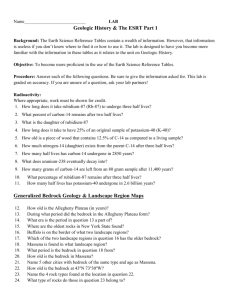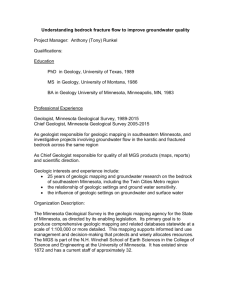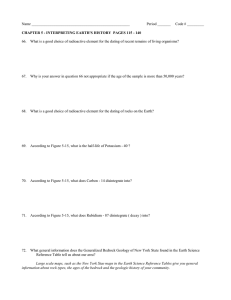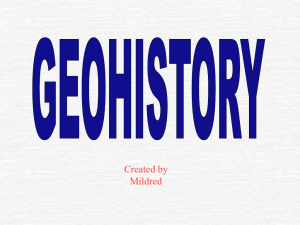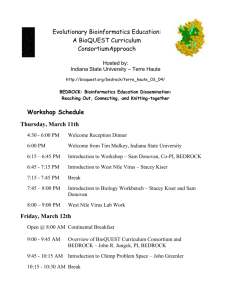GEOLOGIC MAPPING IN SUPPORT OF LAND-USE PLANNING Central Mesabi Iron Range
advertisement
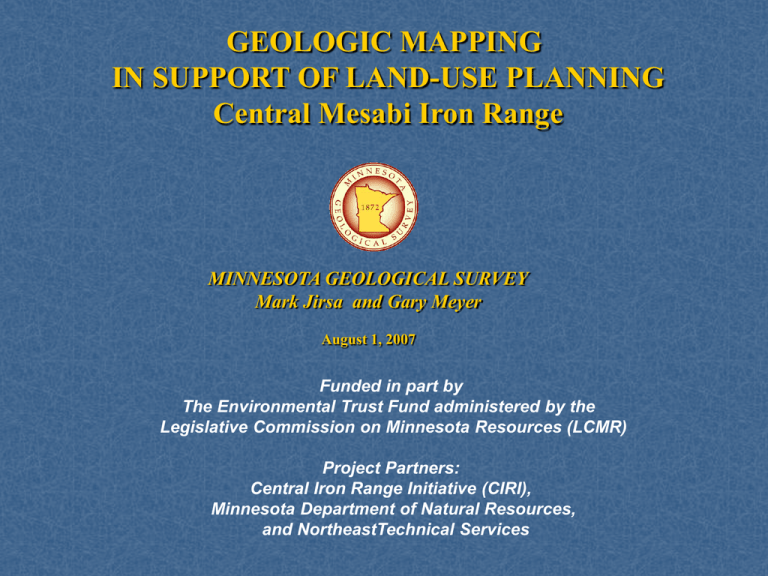
GEOLOGIC MAPPING IN SUPPORT OF LAND-USE PLANNING Central Mesabi Iron Range MINNESOTA GEOLOGICAL SURVEY Mark Jirsa and Gary Meyer August 1, 2007 Funded in part by The Environmental Trust Fund administered by the Legislative Commission on Minnesota Resources (LCMR) Project Partners: Central Iron Range Initiative (CIRI), Minnesota Department of Natural Resources, and NortheastTechnical Services RATIONALE PROVIDE FRAMEWORK GEOLOGIC MAPS AND TECHNICAL DATA TO: Assist planning and development. Guide resource management. Avoid flooding, slumping, and infrastructure damage. Preserve water quality. ULTIMATELY answer the questions: •How high will the waters rise? •What lands can be developed? 1985 2004 Hill Annex State Park REQUIRES UNDERSTANDING: The water balance (Hydrology-DNR) Water in = rain, runoff, groundwater flow Water out = evaporation, groundwater flow, pumping The geologic “container” (Geology-MGS) Groundwater flow through sand and gravel / fractures in rock SUMMARY OF MESABI PROJECTS 1999-2007 1) HYDROGEOLOGIC BASE MAPS OF THE WESTERN AND EASTERN MESABI RANGE (LCMR) Bedrock Topography and Depth to Bedrock -Completed 2001 (W) and 2005 (E) *DNR DIVISION OF WATERS: Site-specific hydrologic study of the CANISTEO PIT COMPLEX 2) BEDROCK AND QUATERNARY GEOLOGIC MAPS OF ENTIRE RANGE (MCC) Geologic maps and ancillary data; completed November 2005 3) CENTRAL IRON RANGE INITIATIVE (CIRI) PROJECT (LCMR) Geologic maps and subsurface data (MGS) *DNR DIVISION OF WATERS hydrologic study -Completion: June, 2007 COLLABORATORS, COOPERATORS, AND FUNDERS MGS Staff: Mining and Fee Company Staff: •Val Chandler •Mike Orobona (Hibtac) •Roger Johnson (GNIOP) •Dale Setterholm •Jeff Price (Keetac) •Doug Halverson (NorthShore) •Rich Lively •Dan England (Eveleth Fee Office) •Al Strandlie and Ron Graber •Emily Bauer •David Meineke (Meriden) (Cliffs) •Bruce Bloomgren •Peter Jongewaard (United) •Frank Pezzutto, Bruce Kniivila, •G.B. Morey •John Arola (ISPAT) Jerry Dombek (Minntac) •Gary Meyer DNR Staff: •Lisa Dosch •Erika Herr •Bob Tipping •John Adams •Tim Wahl •Dan Steinbrink •Carrie Jennings •James Selner •Wade Reynolds •Tim Pastika (mine databases) •Lynn Swanson •Dave Dahl (geophysics) •Lori Robinson NRRI Staff: FUNDING: •Legislative Commission on Minnesota Resources (LCMR) •Julie Oreskovich •Minerals Diversification program of the Minnesota Legislature, •Larry Zanko recommended by Minerals Coordinating Committee (MCC) •Mark Severson •U.S. Geological Survey EDMAP program •Minnesota Geological Survey—State Special funding Mining altered the topography of watersheds WATER ISSUES ~2004 waterline Pump at Scranton Mine, HIBTAC, 2004 Canisteo Pit Complex, 1999 MAPPING the shape of the BEDROCK SURFACE (1999-2002) 2) Hand contouring 1) Compile database 3) Scan and digitize 1899 MAP OF HIBBING AREA Inferred geologic contact Test Pits *Paper on linen maps, scanned and digitized Contrasts in land-surface topography, infrastructure, and surface hydrology 1899 Useful for issues of mine reclamation and watershed restoration 1999 Keewatin Taconite Hibbing Taconite Modified from Lively, Morey, and Bauer, 2002; MGS M-118 CHANGE IN LAND SURFACE TOPOGRAPHY “Mounds” +240 feet 1899-1999 Hibbing Area “Mines” 0 feet -340 feet Lively and others, 2002 estimate ~45% of the 1899 map area was modified by mining BEDROCK AND QUATERNARY GEOLOGIC MAPS OF THE MESABI IRON RANGE 2003-2005 1) Quaternary (glacial sediments) Geologic Map 2) Bedrock Geologic Map 3) Mine-scale Hydrogeologic Data (groundwater “connectivity”) •Funded by the Minnesota Legislature on recommendation of the Minerals Coordinating Committee •Published November, 2005 Dunka pit 2004 FIELD WORK 2003-2006 in most of 400 mines GARY MEYER (MGS) Quaternary geology WADE REYNOLDS Graduate student Quaternary geology CARRIE JENNINGS (MGS) Quaternary studies MARK JIRSA (MGS) Bedrock structure and stratigraphy BEDROCK GEOLOGIC MAP M-163 Mark Jirsa, Val Chandler, and Richard Lively Babbitt Hibbing Grand Rapids Biwabik Iron Formation (~2 billion years old) BEDROCK TYPES Granite and greenstone (~3 billion years old) Hibbing Duluth Complex Gabbro (~1 billion years old) Thomson Formation Jay Cooke State Park (~2 billion years old) QUATERNARY (glacial sediments) GEOLOGIC MAP M-164 Carrie Jennings and Wade Reynolds Babbitt Hibbing Grand Rapids MAPPING QUATERNARY GLACIAL MATERIALS NorthShore Mine 2004 Greenland Advancing lobes of ice GLACIAL LAYERS St. Louis sublobe till (red) Rainy Lobe till (gray) Sand and gravel (variably rounded, sorted) Formed as OUTWASH from the ice Photo source: Carrie Jennings, MGS Sand and gravel (dome shape, poorly sorted) Formed in TUNNEL VALLEY Photo source: Carrie Jennings, MGS Layered sand (rounded pebbles, graded beds) Formed by streams flowing into local lakes Photo source: Carrie Jennings, MGS Canisteo pit lake at Bovey Ironworld pit lake Ironworld pit lake Blast deformation HIBTAC BEDROCK Folds, faults, and fractures m173e Susquehanna •Role as hydrologic conduits •Understand deformation history WR joints Chisholm Mine GROUNDWATER m008g Hill Annex WR Canisteo m365a LTV 6 m131b United S. pit SUMMARY OF FIELD WORK AND OTHER ACTIVITIES Central Mesabi Iron Range 2006-2007 Mark Jirsa and Gary Meyer Minnesota Geological Survey University of Minnesota Funded by the Environmental Trust Fund administered by the Legislative Commission on Minnesota Resources (LCMR) Project Partners: Central Iron Range Initiative (CIRI), Minnesota Department of Natural Resources, and NE Technical Services CENTRAL IRON RANGE INITIATIVE (CIRI) PROJECT LCMR 2006-2007 AREA: Keewatin to Virginia---focus on Chisholm lakes area COOPERATORS: •DNR Waters, Lands and Minerals •Minnesota Geological Survey •NE Technical Services •Architectural Resources Inc. •Barr Engineering •Natural Resources Research Institute •Mining companies HIBTAC OBJECTIVES--ADDRESS FUTURE ECONOMIC DEVELOPMENT ISSUES: •Plan present and future mine landscapes •Create fish-friendly bathymetry •Evaluate energy storage and production •Address water resources issues CENTRAL IRON RANGE Focused study in the Chisholm lakes area Chisholm Lakes Area Digital Elevation Model Central Mesabi Iron Range DNR, 1999 HYDROLOGY OF THE CHISHOLM LAKES AREA Water level gauge Twin City N. Mine MINNESOTA DEPARTMENT OF NATURAL REOURCES DIVISION OF WATERS Erika Herr and John Adams Erika Herr, DNR Waters BATHYMETRY (lake-bottom topography) CHISHOLM LAKES AREA Forster Hartley-Burt Grant Fraser Twin City Sherman MINE WASTE Longyear Lake (1486’) SEDIMENTS Underground mines 100 feet HIBTAC HIBTAC Iron World pit complex Iron World Twin City Sherman Fraser Grant HartleyBurt Forster (1473’) (1343’) 1 mile Vertical exaggeration ~50 X BEDROCK MINNTAC Chisholm Lakes Area HIBTAC KEETAC Sand and gravel-filled bedrock channels DIGITAL BEDROCK TOPOGRAPHY—Chisholm area Iron World Twin City Fraser Forster Sherman Grant 3-D DIGITAL MODELS Land surface elevation and pit lake bathymetry from Department of Natural Resources; Air photo from U.S. Farm Services Administration Imagery by Richard Lively, MGS 3-D MODEL OF CENTRAL IRON RANGE •BEDROCK TOPOGRAPHY (color) from MGS and DNR Bathymetry •LAND-SURFACE TOPOGRAPHY (fade-in, pale color overlay) Click image to start movie “TYPICAL” QUATERNARY SECTION RED CLAY TILL St. Louis sublobe (sources from NW and S), small percentage of rock clasts ~100 feet MESABI TILL Rainy lobe (NE source) bouldery till; locally white, red, yellow, brown, or gray. Yellow stain inferred to represent paleo - water level. Commonly contains thin sand lenses and layers Gary Meyer Localized older, variegated clay till, sand and gravel Twin City south mine, north shore 2005 MINNTAC Red clay till Sand and gravel Gray “Mesabi” bouldery, sandy till Minntac West Pit, 2006 South Agnew Mine, 2006 Thick, layered Sand and gravel DRILLING •Funded by LCMR contract to DNR •Drilled by TRAUT WELL COMPANY •Materials logged by MGS DRILLING •Distribution of subsurface materials (sand vs. clay) •Test material properties •Understand hydrologic connections •Evaluate and quantify hydrologic properties Example of cross-section, based in part on drilling EXAMPLE OF BEDROCK OBSERVATIONS AND INFERENCES From the ALBANY MINE HIBBING HIBTAC-Albany Mine Hibbing photo by David A. Witt, P.G., Aero-Environmental Consulting 2005 HIBTAC-Albany Mine =Seeps PHOTO FAULT ZONE South end, Albany Mine “SUSQUEHANNA FALLS” Hibtac-Hull Rust Mine HIBBING TACONITE Hull-Rust Mine Albany Mine Susquehanna Falls seeps HIBBING Susquehanna Falls Outflow beneath talus feeds waterfall. Algae growth implies warmer water source; possibly derived from Albany mine through bedrock fracture system. METEORIC (surface) WATER SOURCE: Short residence time (if any) in “aquifer” GROUND WATER SOURCE Long residence time(?) in aquifer; may explain common mineral coatings FINAL PRODUCTS Available as Minnesota Geological Survey Open-File Report #07-02: “Bedrock and Quaternary geology of the Central Mesabi Iron Range, northeastern Minnesota” by Mark A. Jirsa and Gary N. Meyer Printable pdf maps (shown on the following slides) 1. Bedrock Geology map All products in digital format only. 2A. Bedrock topography map 2B. Bedrock topography-Chisholm area 3. Depth to bedrock map 4A. Surficial geologic map 4B. Sand and gravel units (shows cross-section line) 5. Lineaments map 6. Geologic cross-section 7. Locations of field observations Other digital files: • Abstract and Readme documents • Shapefiles of all covers incorporated into pdf maps (above); station locations (correspond to photographs) • Tables of textural analyses of representative Quaternary materials • Digital photographs (keyed to stations) • This PowerPoint presentation 1. BEDROCK GEOLOGIC MAP Shows distribution of bedrock geologic units beneath unconsolidated sediments and exposed in natural rock outcrops and mines. 2A. BEDROCK TOPOGRAPHIC MAP Shows elevation of top of the bedrock surface beneath unconsolidated materials; areas of active and previous mining shown in pink. White=high topography Black=low 2B. BEDROCK TOPOGRAPHYCHISHOLM AREA Shows detail of bedrock surface in area of focused study. CHISHOLM White=high topography Black=low 3. DEPTH TO BEDROCK MAP Shows thicknesses of unconsolidated materials. Bedrock outcrops shown in red and mining areas shown in black represent zero thickness. White=thick sediment cover Black=thin 4A. SURFICIAL GEOLOGIC MAP Shows surface distribution of unconsolidated glacial sediments. White areas represent surface materials disturbed by mining. 4B. SAND AND GRAVEL UNITS Shows distribution of known sand and gravel units near-surface (green) and at depth (tan). 5. LINEAMENTS AND BEDROCK STRUCTURE Shows orientation of faults, folds, joints, veins, diabase dikes, bedding, and planar foliation in bedrock; at map and outcrop scales. 6. GEOLOGIC CROSS-SECTION Shows distribution of unconsolidated glacial and man-made materials at and beneath the land surface. W E Example of detail in a cross-section Red clayey till Waste dump Elevation (ft.) Tailings Overburden dump Tan, rocky and sandy till Gray clayey till Sand BEDROCK Note: “till” is a mixed sediment containing various proportions of rocks, sand, silt, and clay 35 MILE SECTION: Along a line from Nashwauk to Virginia 7. MAP OF FIELD OBSERVATION POINTS Shows locations of observations, including material descriptions, samples, measurements, and photographs. Red points are primarily related to bedrock observations; green to observations of unconsolidated materials.
